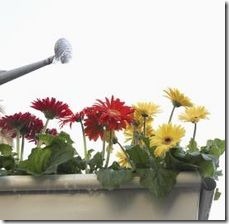The gerbera daisy (Gerbera jamesonii), also known as the Transvaal or African daisy, is a small tropical perennial plant bearing brilliant-hued composite flowers. The flower is grown indoors or as a windowbox annual in most of North America, but thrives as a perennial landscape border or bedding plant in the southernmost reaches of the United States. Its blossoms hold their liveliness for nearly two weeks in a vase, making them ideal cut flowers.
Form
-
The gerbera daisy plant grows from a central stem with coarsely serrated leaves about 10 inches long encircling the stem near ground level in a loose rosette form. In late spring, one or more sturdy 12-to-18 inch flower stems grow straight up from the leafy rosette. Each stem is topped with one composite flower, which, like a sunflower, includes a disc of numerous small florets in the center, and dozens of rays or petals symmetrically arrayed around the disc. Breeders have created gerbera daisy flowers in dozens of neon-bright hues.
History
-
Gerbera plants were first brought to Europe in the late 19th century by a Scottish diplomat, Dr. L.S.Jameson, who was operating a gold mine in the Transvaal, South Africa, according to biology professors of Union County College, New Jersey. Jameson sent samples of the plant on to African botanical gardens, where botanists forwarded specimens to England’s Kew Gardens. Breeding gerberas for better color, flower size and longevity then occurred in England and the Netherlands. Gerberas reached American gardens in the 1920s, where breeders continue to the present day to develop new varieties for various purposes like cut flowers, containers and bedding plants.
Propagation
-
Gerbera daisy plants can be propagated from seed, but they require special conditions to ensure germination, according to the Alabama Cooperative Extension. Gerbera seeds must be fresh to ensure reasonable germination rates. The seeds are sprinkled on the surface of a soil-less growing medium that is warmed from below with heat mats to around 72 degrees Fahrenheit, and kept in near 100 percent humidity. Some commercial growers specialize in gerbera seed germination, and sell flats of plugs of gerbera seedlings to growers who then raise the plants for nursery or cut-flower sale. Home gardeners can propagate gerberas more easily by division, advises the Union County College biology department. Mature gerbera plants sprout offset side growth from the main stem that can be divided in the spring and replanted to start new plants.
Plant Culture
-
Gerbera daisy plants require full sun, and soil that stays moist to maintain high humidity around the plant. Temperature for optimum gerbera plant growth and flower production is in the low 70s. Indoors, artificial plant lights can substitute for sunlight in darker months in winter climates, as long as they are bright and left on approximately 14 hours a day. The soil must remain slightly acidic for gerbera plants to thrive and bloom — a pH of 5.5 and 6.2 is best, according to the Alabama Cooperative Extension Service.


Deprecated: strpos(): Passing null to parameter #1 ($haystack) of type string is deprecated in /home/agriviek8Qv/agriviet.net/public_html/wp-includes/comment-template.php on line 2522